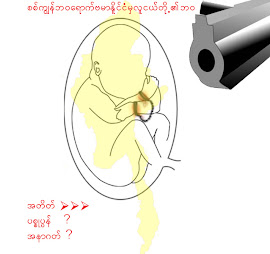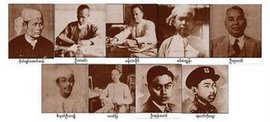Where Are The Monks?
 The 26-year-old monk was one of thousands who took to Burma's streets in late September. Like so many of them he had never imagined himself an activist—"I'm a normal monk, I'm not a political monk," he says—but he was carried away by the democratic fervor then sweeping Rangoon. On Sept. 25 he returned to his monastery late at night, climbing over the back wall since the front entrance was locked. The next night the soldiers came and took him away.
The 26-year-old monk was one of thousands who took to Burma's streets in late September. Like so many of them he had never imagined himself an activist—"I'm a normal monk, I'm not a political monk," he says—but he was carried away by the democratic fervor then sweeping Rangoon. On Sept. 25 he returned to his monastery late at night, climbing over the back wall since the front entrance was locked. The next night the soldiers came and took him away. He was not the only monk to vanish, either from his monastery or dozens of others. The few foreigners who have managed to enter Burma since the junta's crackdown have all noted how empty the country's temples and monasteries seem to be. Thought to number around 400,000, Buddhist monks had been ubiquitous in Rangoon, Mandalay and other Burmese cities for centuries. "Something has happened," says Shari Villarosa, chargé d'affaires at the U.S. Embassy in Rangoon. "It's frightening to think of. It's not like they all willingly left town."
In interviews, diplomats, monks and Burmese activists say that the junta has jailed those monks it sees as ringleaders and has persuaded abbots—some of them already collaborating with the regime—to get rid of dissidents. Many monks have been placed under "monastery arrest," forbidden to leave their campuses, except to collect their daily alms. Others have been forcibly derobed. And some terrified monks have fled to the countryside or to neighboring Thailand and China. "The monasteries in my neighborhood seem empty," says the 26-year-old monk, who was jailed for 19 days. "In my monastery, we used to have 100. Now we're down to about 31. I can feel the silence."
Those few monks visible at the Shwedagon temple in Rangoon, a magnificent, sprawling complex of pagodas anchored by a glittering 2,500-year-old stupa, move around cautiously, mostly alone. In Amarapura, near Mandalay, the number of monks who queue up for lunch each day at the Mahagandayon monastery—a daily ritual once mobbed by tourists—has also declined dramatically. A 27-year-old cleric there says almost 1,000 of the monastery's 1,800 inhabitants fled to their home provinces in September, although he says many have since slipped back.
The 26-year-old Rangoon monk—a tall man with an elegant shaved head and an easy smile—says soldiers treated him roughly in detention but did not beat him, although they did slap around several other monks. For the first 15 days no latrines or bathing facilities were provided. Interrogations were basic: "We were mainly asked, 'Did you participate in the protests? Why? Who is the leading monk in these protests?' " Soldiers then brought in Sangha nayakas—Buddhist officials authorized to convert monks to laypeople. The nayakas refused to recite the appropriate scripture, so the soldiers simply forced the monks to don civilian dress and pronounced them laymen. "I took my vows a long time ago," says the defiant monk, still wearing his prison-issue flip-flops. "I felt angry to be forced to change my clothes, but I was still a monk."
The government concedes that a few monks remain in detention, although it claims to have released all but about 90 of the 3,000 monks and civilians initially jailed. Outside the major cities monks are far more evident. In Sagaing, west of Mandalay, groups of them roam the lush hillside, taking tea and chatting amiably with locals. The mood at the gorgeous Kaunghmudaw pagoda is calm. "Not a surprise," says a tour guide. "Here, they're far from the action, and remember, some abbots work with the government." He mentions the pro-government Kya Khat Waing monastery in Bago, about 50 miles northeast of Rangoon, most of whose monks did not march and whose abbot urged the government to punish those who did.













1 comment:
There has been little follow-up to some of the early clues as to where the monks went. Take this Times Online report for example:
http://tinyurl.com/3bjw6q
Secret cremations hide Burma killings
THE Burmese army has burnt an undetermined number of bodies at a crematorium sealed off by armed guards northeast of Rangoon over the past seven days, ensuring that the exact death toll in the recent pro-democracy protests will never be known.
The secret cremations have been reported by local people who have seen olive green trucks covered with tarpaulins rumbling through the area at night and watched smoke rising continuously from the furnace chimneys.
They say they have watched soldiers in steel helmets blocking off roads to the municipal crematorium and threatening people who poke their heads out of windows overlooking the roads after the 10pm curfew.
Their accounts have been volunteered to international officials and aid workers in Rangoon, Burma’s main city. The consensus in the foreign community is that the consistency of the stories makes them credible.
STORY CONTINUES - visit the link...
+++++++
Not only that, but the best sources of inside information are simply not being pursued by the media. It seems obvious that no one WANTS to know where the monks went. They are scared of discovering something that might make them feel uncomfortable.
Major General Hla Htay Win (at least I think that is his name, because the reporting on him was inconsistent to say the least)reportedly was in command of Rangoon during the initial stages of the protest and was relieved of duty for not firing on the protestors, and reportedly defected to Thailand with plans to seek asylum in Norway. He told journalists that thousands had been killed. Then he was subsequently ignored by the press. To the international press: Nice work!
Regarding the thousands of monks supposedly imprisoned, one might reasonably wonder what will happen to them. The PRC is probably running out of anonymous Falun Gong detainees from Oct. 25, 1999 that were used to jump start their organ harvesting industry. (Yes - it's all true.) http://tinyurl.com/yq7duo
Don't be surprised if the missing monks are never seen again and China's source of organ transplants mysteriously seems neverending.
But apparently the UN's man-on-the-scene, Gambari, has agreed that only "15" people were killed in the crackdown. http://tinyurl.com/344ow2
It's enough to make one's head spin!
Great work you've been doing with your blog! Keep it up.
Post a Comment